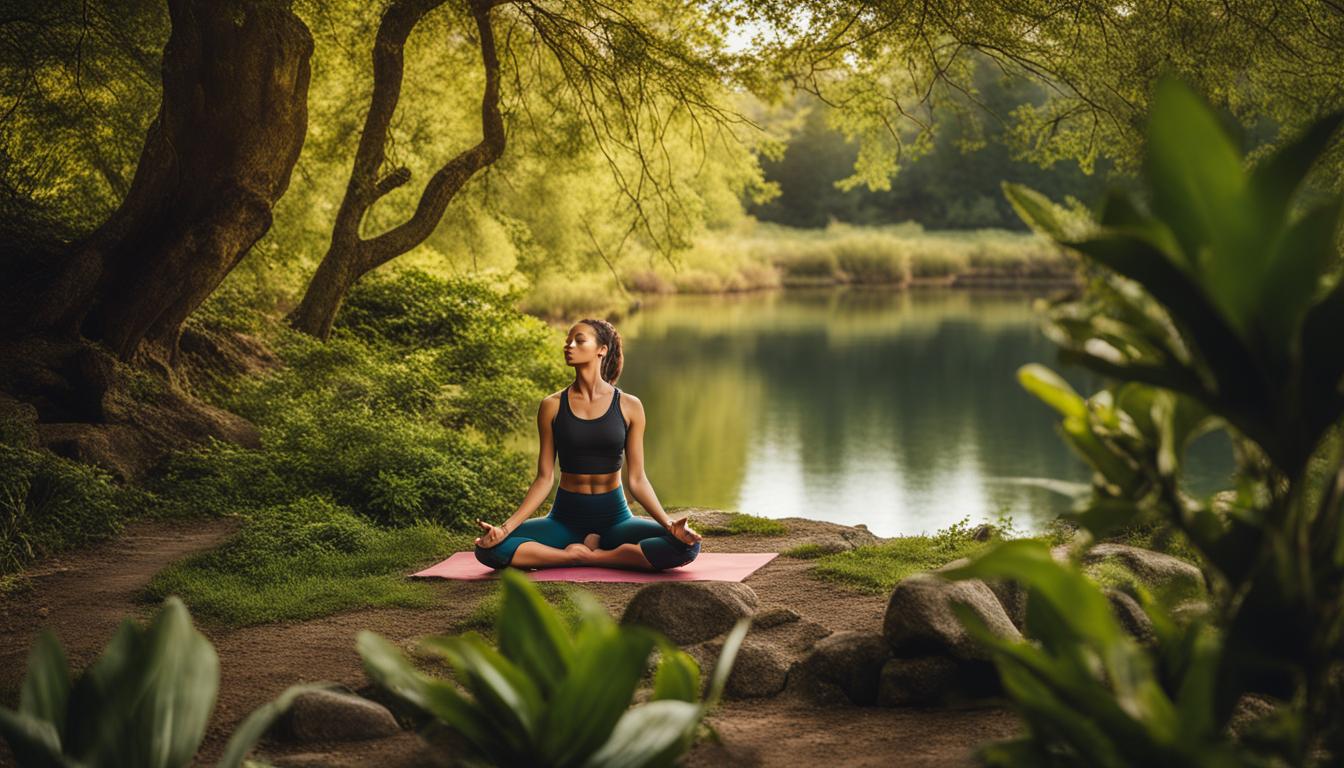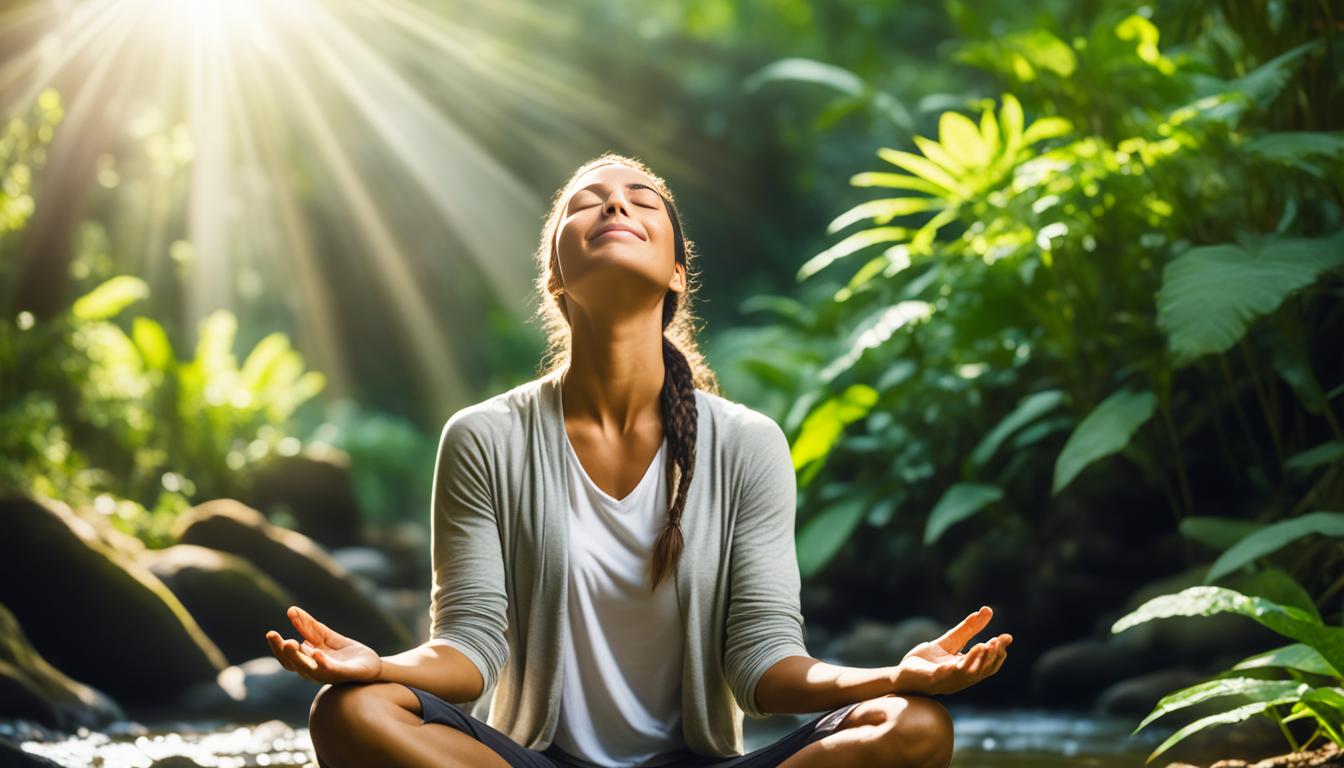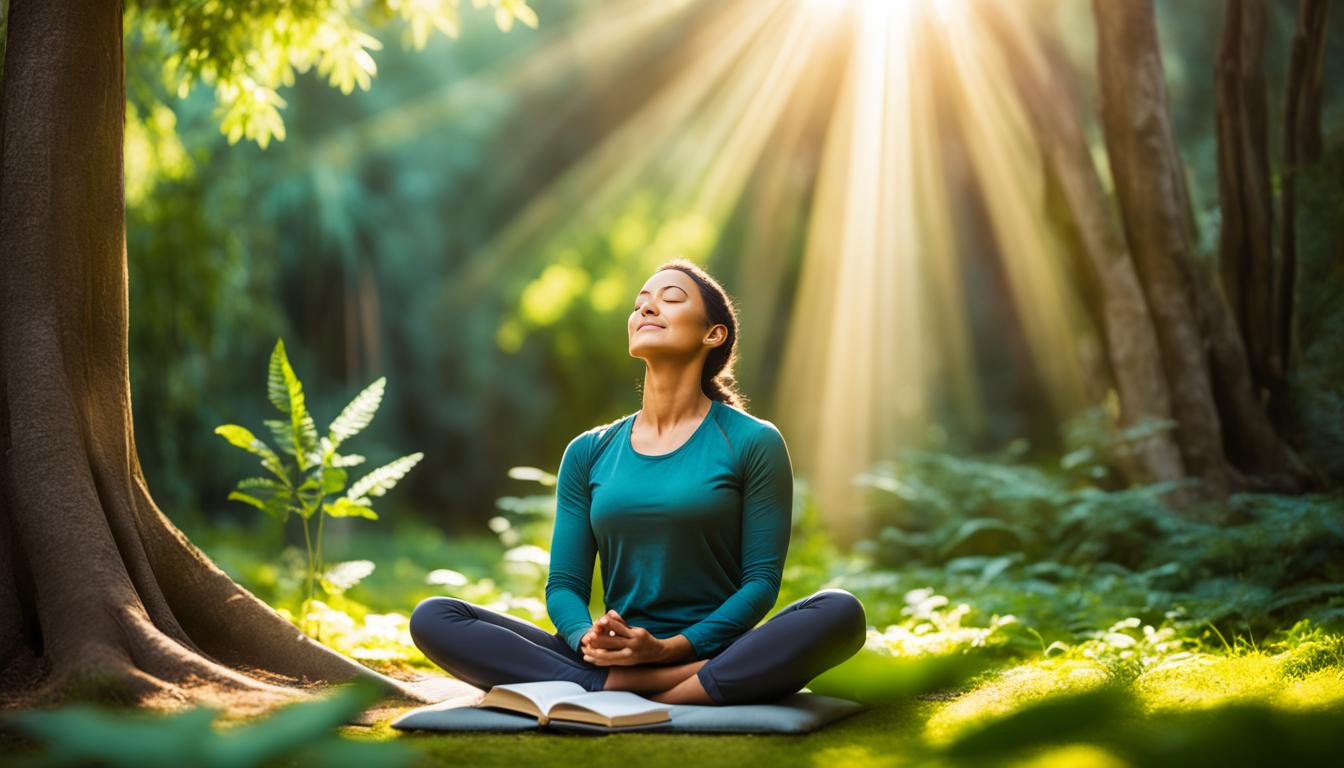Disclosure: This Post Contains Affiliate Links; We earn a commission on purchases.
Welcome to an exploration of the art of meditation and the techniques that can lead to success. If you’ve ever felt overwhelmed or stressed and needed a way to find inner peace and clarity, then meditation may be the answer you’ve been seeking. This ancient practice has been embraced by people from all walks of life, including writers, artists, entrepreneurs, and spiritual seekers.
In this article, we will delve into the world of meditation techniques and how they can transform your life. We will draw insights from Laura Roe Stevens, a freelance writer and yoga teacher, who will share her personal journey with meditation and the profound impact it has had on her writing and overall well-being.
Key Takeaways:
- Meditation offers numerous benefits, including increased presence, a calm mind, and reduced stress levels.
- By incorporating meditation into your daily routine, you can enhance your creativity, focus, and overall sense of well-being.
- Mindfulness meditation, breathing techniques, visualization techniques, guided meditation, body scan meditation, mantra meditation, and loving-kindness meditation are just a few of the wide range of techniques available to explore.
- Understanding the ten stages of meditative training and the meditation process can provide a roadmap for personal growth and progress.
- Meditation is a journey that requires dedication, patience, and a willingness to embrace the present moment. The rewards are profound and can positively impact every aspect of your life.
Laura Roe Stevens: From Shy Writer to Yoga Teacher
Laura Roe Stevens, a talented freelance writer and experienced yoga teacher, has had a remarkable journey in both her professional and personal life. Starting her career at a young age, Laura has delved into various topics, showcasing her versatility and skill. Through her work as a writer and her passion for yoga, Laura has found a unique connection between her writing and meditation practices.
As a successful freelance writer, Laura has covered a wide range of subjects, including business, careers, parenting, and dating. Her ability to dive deep into these topics and deliver engaging content has earned her a reputation as a reliable and sought-after writer. However, it is her dedication to yoga and meditation that has brought significant changes to her approach to writing and creativity.
Stevens draws inspiration from her travels, allowing her to embrace diverse cultures and perspectives. This exposure has further enriched her writing, providing a unique perspective and captivating her readers. Additionally, her extensive training and experience as a yoga teacher have significantly influenced her meditation practice.
“Yoga has taught me the importance of mindfulness and being present in the moment,” says Laura Roe Stevens. “It has heightened my awareness and sharpened my focus, which in turn has had a profound impact on my writing. Meditation has become an integral part of my creative process.”
Stevens finds that the combination of yoga and meditation not only enhances her writing but also fosters overall well-being. By incorporating meditation into her daily routine, she has cultivated a sense of clarity, calmness, and centeredness, allowing her to tap into her creative reservoirs more deeply.
Whether it’s through the practice of mindfulness during writing or finding inspiration through meditation, Laura Roe Stevens has discovered a powerful synergy between her roles as a freelance writer and yoga teacher. This fusion has not only unlocked new dimensions in her work but also propelled her personal growth and self-expression.
Through her experiences, Laura serves as an inspiration to aspiring writers and yoga enthusiasts, showcasing how the integration of mindfulness, meditation, and creativity can lead to profound transformation.
Stay tuned for the next section, where we will delve into the basics of meditation and explore the techniques that can help you achieve a state of mindfulness and inner peace.
The Basics of Meditation
Mindfulness meditation is a powerful technique that allows individuals to cultivate present-moment awareness and develop a sense of inner peace. By paying attention to the breath and anchoring our focus in the present moment, mindfulness meditation builds attention and mindfulness. It involves acknowledging our thoughts, emotions, and bodily sensations without judgment or attachment, creating space for self-reflection and personal growth.
One of the key elements of mindfulness meditation is the use of breathing techniques. Focusing on the breath helps to anchor our attention and bring our focus back when the mind wanders. By observing the inhalation and exhalation, we cultivate a sense of calmness and centering. Breathing techniques can vary, but they often involve deep, slow breaths and conscious awareness of the rhythm of the breath. These techniques can help alleviate stress, reduce anxiety, and promote relaxation.
Visualization techniques are another valuable tool in meditation. Through visualizing calming or positive images, individuals can enhance their ability to relax and focus their attention. Visualization can involve imagining beautiful landscapes, serene natural settings, or even visualizing themselves attaining their goals and aspirations. By engaging the power of visualization, individuals can tap into their imagination and create a mental state that promotes tranquility and inner peace.
“The breath is the anchor to the present moment; in it, we find our grounding and our center.” – Laura Roe Stevens
Mindfulness meditation, breathing techniques, and visualization techniques work synergistically to create a profound meditative experience. They allow individuals to quiet the mind, release tension, and tap into a sense of deep inner calmness. By incorporating these practices into our daily lives, we can enhance our overall well-being, reduce stress, and cultivate a greater sense of inner harmony.
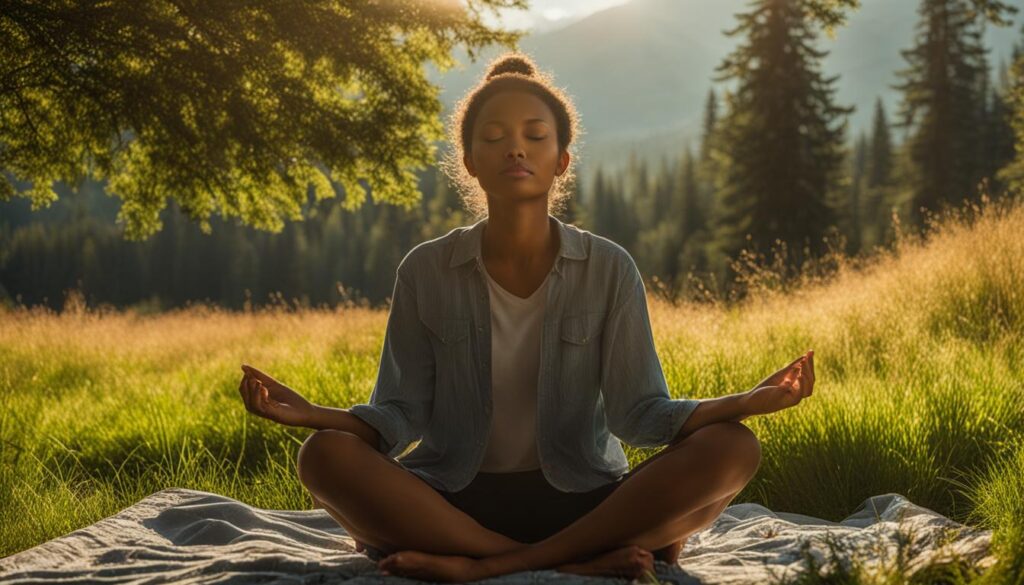
Getting Started with Meditation
To begin your meditation practice, it’s important to create a serene environment that allows for deep focus and relaxation. Find a calm and quiet place where you feel comfortable and can sit undisturbed for the duration of your meditation session. Setting a time limit for your practice can help you stay committed and gradually increase your meditation duration over time.
There are various meditation techniques that can help you focus your mind and cultivate a sense of peace within. Let’s explore three popular techniques: guided meditation, body scan meditation, and walking meditation.
Guided Meditation
Guided meditation involves listening to a recorded voice or following along with a meditation app that provides instructions and gentle guidance throughout the practice. This technique is especially helpful for beginners as it provides structure and support, making it easier to stay focused and relaxed. Guided meditations often incorporate elements of visualization, breathing techniques, and progressive relaxation.
Body Scan Meditation
Body scan meditation involves systematically directing your attention to different parts of your body, starting from the top of your head and moving down to your toes. As you bring awareness to each part, you notice any sensations, tensions, or areas of relaxation. This technique helps to cultivate deep body awareness and release physical and mental tension.
Walking Meditation
Walking meditation is a mindfulness practice that involves walking slowly and intentionally while maintaining awareness of your body and surroundings. With each step, you focus on the sensations in your feet, the movement of your legs, and the rhythm of your breath. Walking meditation can be done indoors or outdoors, providing a refreshing change of scenery and an opportunity to connect with nature.
Remember, meditation is a personal practice, and it’s important to choose a technique that resonates with you. Experiment with different techniques and find the ones that bring you the most peace and tranquility. Tailor your practice to suit your needs and preferences, allowing it to evolve and grow with you on your meditation journey.
| Technique | Description |
|---|---|
| Guided Meditation | Listening to a recorded voice or following an app for guided instructions and support. |
| Body Scan Meditation | Systematically directing attention to different parts of the body to cultivate deep awareness. |
| Walking Meditation | Mindful walking with attention to body sensations and the surrounding environment. |
The Power of Meditation
Among the various meditation techniques, two practices stand out for their profound impact on emotional well-being and relationships: mantra meditation and loving-kindness meditation.
Mantra Meditation
Mantra meditation is a technique that involves the repetition of a word or phrase, known as a mantra, to focus the mind and create a sense of inner calm. By silently repeating the chosen mantra, individuals can quiet the chatter of their thoughts and achieve a state of deep relaxation.
Mantras can be in any language and may have personal or cultural significance. Some popular mantras include “Om,” “Sat Nam,” and “So Hum.” The rhythmic repetition of the mantra helps to anchor the mind, deepen concentration, and facilitate a greater sense of inner peace.
Loving-Kindness Meditation
Loving-kindness meditation, also known as metta meditation, involves cultivating feelings of compassion, love, and goodwill towards oneself and others. It aims to develop empathy, reduce negative emotions, and enhance positive relationships.
This practice typically begins with directing loving-kindness towards oneself, then gradually expands to include loved ones, acquaintances, neutral individuals, and even difficult people. By actively nurturing thoughts of kindness and well-wishing, individuals can foster a genuine sense of connection and empathy, leading to greater happiness and emotional well-being.
Studies have shown that loving-kindness meditation can increase feelings of positive emotions, reduce symptoms of depression and anxiety, and improve social interactions.
“Loving-kindness meditation has completely transformed the way I relate to others. It has opened my heart and allowed me to see the interconnectedness of all beings.” – Laura Roe Stevens
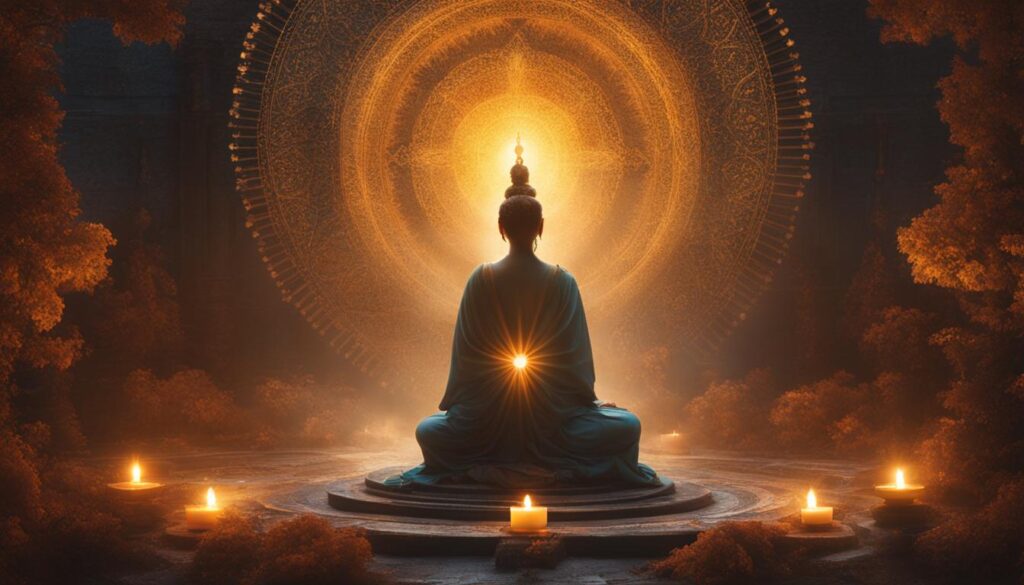
| Benefits of Mantra Meditation | Benefits of Loving-Kindness Meditation |
|---|---|
|
|
The Ten Stages of Meditative Training
The practice of meditation involves a journey that unfolds through ten stages of meditative training. Each stage offers its own unique characteristics, challenges, and techniques for growth. These stages act as milestones on the path to mastery, marking gradual improvements in meditative abilities and deepening one’s practice.
Stage 1: Establishing Presence
- Developing attention and focus on the meditation object
- Overcoming mind-wandering and forgetting
- Achieving continuous attention through sustained effort
Stage 2: Sustained Exclusive Attention
- Overcoming gross distractions and cultivating strong mindfulness
- Subduing subtle distractions through increased awareness
- Achieving sustained and exclusive focus on the meditation object
Stage 3: Cultivating Joy
- Generating a deep sense of joy and tranquility in meditation
- Developing emotional balance and equanimity
- Cultivating positive qualities such as compassion and loving-kindness
Stage 4: Overcoming Mental Restlessness
“When the mind is restless, turbulent, or haunted by a sense of dissatisfaction, meditation can help bring calm and peace.” – Laura Roe Stevens
Stage 5: Developing One-Pointedness
- Refining focus and concentration
- Experiencing deep absorption and single-pointed attention
- Cultivating clarity and stability of mind
Stage 6: Balancing Effort and Relaxation
“Finding the right balance between effort and relaxation in meditation is essential for continued progress.” – Laura Roe Stevens
Stage 7: Establishing Mindfulness
- Developing sustained mindfulness in daily life
- Integrating meditation into daily activities
- Deepening self-awareness and present moment awareness
Stage 8: Cultivating Equanimity
- Developing an even-minded and non-reactive attitude
- Cultivating acceptance and letting go of attachments
- Fostering inner peace and balance
Stage 9: Cultivating Insight
“Insight arises when we begin to see the impermanence, unsatisfactoriness, and selflessness nature of all phenomena.” – Laura Roe Stevens
Stage 10: Attaining Transcendence
- Experiencing transcendence and liberation
- Realizing the true nature of reality
- Attaining spiritual growth and ultimate enlightenment
Progressing through these ten stages requires dedication, practice, and a deep understanding of the meditative process. Each stage builds upon the previous one, laying a foundation for personal development and profound transformation.

How the Process Unfolds in Meditation
The process of meditation is a journey of growth and self-discovery. It involves developing specific skills and mastering each stage before progressing to the next. While the stages are presented as a linear progression, the practice often involves navigating multiple stages simultaneously, creating a dynamic and interconnected process.
Individual progress in meditation may vary. It is important to approach the practice with an open mind and meet yourself where you are in your current experience. Trying to force progress can hinder your meditation journey. Instead, focus on cultivating diligence and patience, allowing yourself to naturally evolve and grow.
Throughout the meditation process, each stage builds upon the previous one, creating a solid foundation for further development. As you gain mastery over your meditation techniques, you will begin to notice improvements in your focus, attention, and overall well-being.
“Meditation is not a race or competition. It is a personal exploration of the mind and inner landscape. Honor your progress and be kind to yourself along the way.” – Laura Roe Stevens
The Stages of Meditation:
- Establishment of a daily practice
- Cultivation of attention
- Overcoming mind-wandering and forgetting
- Developing sustained focus and mindfulness
- Subduing gross distractions and increasing awareness
- Subduing subtle distractions and deepening concentration
- Achieving sustained exclusive attention to the meditation object
- Attaining perfect stability and equanimity
- Unifying the mind and experiencing deep tranquility
- Attaining the ultimate state of meditation
Each stage represents a milestone in your meditation progress, offering unique challenges and opportunities for growth. It is through consistent practice and dedication that you will move closer to the ultimate state of meditation.
Remember, the meditation process is not only about reaching the end goal but also about embracing the present moment and enjoying the journey. By cultivating patience, perseverance, and self-compassion, you can unlock the transformative power of meditation and experience profound personal and spiritual growth.
The Rate of Progress in Meditation
Progress in meditation can vary depending on individual factors such as natural abilities, discipline, and life circumstances. While some may experience rapid progress through the stages with regular daily practice, others may take longer due to various factors. Understanding each stage, working diligently, and integrating meditation into daily life are key factors in making efficient progress in meditation.
It’s important to remember that meditation is a personal journey, and each individual’s progress will be unique. Comparing oneself to others or expecting quick results can hinder the process. Instead, focus on your own growth and celebrate the milestones achieved along the way.
Meditation milestones serve as markers of progress and provide a sense of accomplishment. They can vary depending on the meditation technique and personal goals. Here are some commonly celebrated milestones:
| Meditation Milestone | Description |
|---|---|
| Consistent Daily Practice | Establishing a regular meditation routine, practicing every day. |
| Increased Focus and Concentration | Noticing improvements in the ability to focus and maintain attention. |
| Greater Sense of Inner Peace | Feeling a deep sense of calm and tranquility during meditation sessions. |
| Heightened Self-Awareness | Becoming more aware of thoughts, emotions, and internal experiences. |
| Emotional Resilience | Developing the ability to respond to challenging emotions with equanimity. |
These milestones can vary from person to person, but they provide a sense of progression and reinforce the benefits of a dedicated meditation practice.
Remember that progress in meditation is not always linear. There may be times of stagnation or challenges along the way. Embrace these moments as opportunities for growth and continue to persevere.
Keep in mind that meditation is about the journey rather than the destination. Enjoy the process, celebrate milestone achievements, and trust that consistent practice will lead to profound personal transformation.
The Novice Meditator: Stages One to Three
Establishing a regular practice is the first milestone in meditation.
The journey of a novice meditator begins with stages one to three, laying the foundation for further growth and mastery. During these early stages, the focus is on developing attention, overcoming mind-wandering and forgetting, and achieving continuous attention to the meditation object.
Stage One: Establishing Attention
In stage one, the novice meditator learns to establish attention by choosing an object to focus on, such as the breath or a mantra. The goal is to train the mind to stay present and avoid distractions.
A helpful technique is to count the breaths, anchoring attention and building mindfulness. As thoughts arise, the meditator gently returns their focus to the chosen object.
Stage Two: Overcoming Mind-Wandering and Forgetting
Mind-wandering and forgetfulness are common challenges in meditation. In stage two, the meditator becomes aware of distractions and learns to recognize when they lose focus.
The practice involves acknowledging distractions without judgment and gently returning attention to the chosen object whenever the mind wanders or forgets. Consistent effort and patience are crucial during this stage.
Stage Three: Achieving Continuous Attention
In stage three, the meditator aims to achieve sustained attention to the meditation object. Distractions become less frequent as focus and mindfulness deepen.
The practice involves noticing subtle distractions and developing the ability to let them go, allowing for longer periods of uninterrupted attention. With practice, the meditator can experience moments of single-pointed concentration and improved clarity of mind.
Benefits of Novice Meditation
Establishing a regular meditation practice as a novice offers numerous benefits. It cultivates mindfulness, reduces stress, enhances self-awareness, and promotes overall well-being. Through consistent effort and dedication, the novice meditator can lay a strong foundation for personal and spiritual growth.
The Skilled Meditator: Stages Four to Six
In the journey of meditation, the skilled meditator progresses through stages four to six, advancing their practice and deepening their mindfulness. These stages focus on overcoming various distractions and dullness, allowing for increased levels of concentration and awareness.
Stage four marks the meditator’s journey in overcoming gross distractions. With diligent practice, they learn to recognize and let go of thoughts, emotions, and sensations that arise during meditation. By cultivating a steady and calm mind, they can redirect their attention back to the meditation object.
“The key to overcoming distractions is to remain non-reactive and gently bring the focus back to the present moment,” explains Laura Roe Stevens, a skilled meditator and seasoned yoga teacher.
As the meditator progresses to stage five, they confront the challenge of subtle distractions. These distractions may manifest in the form of subtle thoughts, mild sensations, or background noise. With heightened mindfulness, they develop the ability to discern and let go of these distractions, allowing for a deeper level of focus.
Stage six involves subduing subtle dullness and increasing the level of alertness in meditation. The meditator becomes more sensitive to the presence of dullness and learns to counteract it by applying techniques such as increasing the brightness of awareness or adjusting posture. By maintaining a balanced state of relaxation and vigilance, they can attain sustained and exclusive attention to the meditation object.
This steady progress through these stages leads the meditator to achieve milestone two: sustained exclusive focus of attention. With consistent practice and overcoming distractions, the skilled meditator experiences deep states of concentration and continuous connection with the present moment.
To illustrate the progression of the skilled meditator, refer to the table below:
| Stage | Focus | Challenges | Achievements |
|---|---|---|---|
| Four | Overcoming gross distractions | Recognizing and letting go of thoughts, emotions, and sensations | Redirecting attention back to the meditation object |
| Five | Overcoming subtle distractions | Discerning and letting go of subtle distractions | Deeper level of focus and mindfulness |
| Six | Subduing subtle dullness | Increasing alertness and overcoming dullness | Sustained and exclusive attention to the meditation object |
Conclusion
Meditation is a transformative practice that requires dedication and patience. By incorporating various meditation techniques and following the ten stages of meditative training, individuals can embark on a journey of personal and spiritual growth, leading to increased self-awareness, reduced stress levels, and enhanced overall well-being.
The art of meditation offers numerous benefits, allowing practitioners to cultivate a calm and focused mind, develop emotional resilience, and cultivate greater harmony in their lives. Mindfulness meditation, breathing techniques, visualization, mantra repetition, and loving-kindness meditation are just a few of the techniques that can be used to deepen one’s meditative practice and experience the profound effects of meditation on the mind, body, and spirit.
Whether you are a novice meditator just beginning to establish your practice or a skilled meditator honing your skills to overcome distraction and achieve sustained focus, meditation is a powerful tool for personal transformation. It provides a pathway to tranquility, self-discovery, and a profound connection with oneself and the world. Embrace the journey, commit to the practice, and unlock the transformative power of meditation in your life.
Ryan Conlon is a passionate advocate for mindfulness and meditation, dedicated to helping others discover the transformative power of these practices in their lives. As the founder of Daily Meditation, Ryan’s mission is to provide a sanctuary for individuals seeking peace, clarity, and well-being amidst the chaos of modern life. With a background in psychology and years of personal experience with meditation, Ryan brings a wealth of knowledge and insight to his work. Through Daily Meditation, he shares practical guidance, inspirational content, and expert resources to support others on their journey toward greater mindfulness, resilience, and inner peace.
Subscribe to Our Newsletter






